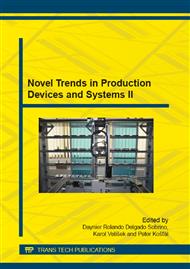p.293
p.299
p.305
p.311
p.317
p.323
p.329
p.335
p.340
Mechatronic Approach to the Modeling of Machine Aggregates
Abstract:
Significant development of the new production technologies requires an adequate development of the production systems on which these technologies carried out. It is obvious that those facts affect the structural design of new advanced manufacturing systems and also require both research and development of new drive systems. In this context [1], drive systems have the character of complex dynamic systems with elements, resp. subsystems, which have both the different physical nature and in many cases are characterized by control, i.e. having features of the mechatronic systems. The conception of mechatronic drive systems modelling consists of an integration of knowledge from various technical disciplines (i.e. mechanics, electronics, control) to obtain a product with highest possible technical and economical parameters. In this light, the machine aggregates must be modelled as dynamic systems to drive a plant (mechanical load, mechanical working equipment) and to control the technological process.
Info:
Periodical:
Pages:
317-322
Citation:
Online since:
December 2014
Authors:
Price:
Сopyright:
© 2014 Trans Tech Publications Ltd. All Rights Reserved
Share:
Citation:


